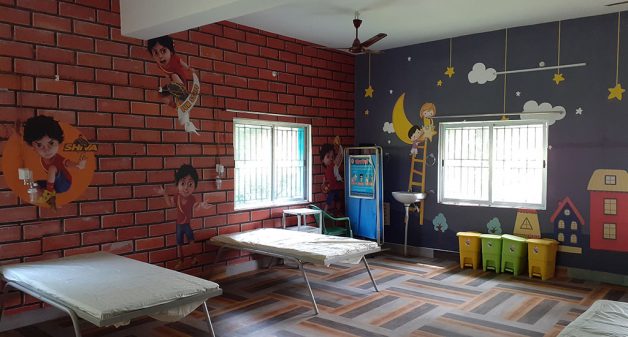While the second wave of COVID-19 that hit our country left a trail of fatalities, in addition to economic and social crises, health experts warn of a third wave. “It is inevitable…we should be prepared,” Vijay Raghavan, principal scientific advisor to the government, has cautioned. Many states and union territories have started ramping up their health infrastructure, specially the COVID-19 pediatric wards.
The health secretary of Jharkhand fears that the third wave may infect around 7 lakh children and adolescents in Jharkhand and about 9,000 of them may need intensive care, while about 42,000 may show moderate symptoms. Expressing his concern that the state has only 125 child specialists; he estimates that around 50,000 oxygenated beds will be required.
Jharkhand’s experience during the second wave shows that a set of measures would help face the third wave. Strengthening of local administration, civil society organizations lending them support and their synergic work with community collectives is a potential way of overcoming the situation, when it arises.
Insufficient facilities
About 97% of the Jharkhand’s total land is rural, half of which is classified as tribal area. Nearly 75% of its total 2.79 crore population lives in rural areas with population density of 361. It is home to 27 particularly vulnerable tribal groups (PVTGs).
According to norms, Jharkhand requires 6,768 health subcenters (HSCs), 1,079 primary health centers (PHCs) and 269 community health centers. But as per Rural Health Statistics 2019 of Ministry of Health and Family Welfare, only 3,848 subcenters (shortfall 43%), 298 PHCs (shortfall 72%) and 271 CHCs (shortfall 36%) exist.
These centers function without basic facilities like regular water supply and electricity. It is reported that 56.2% of the HSCs and 65.5% PHCs do not have regular running water; 65.7% HSCs and 55% PHCs do not have electricity. 20.2% of the PHCs do not have a labor room and 58.2% do not have an operation theatre. At a time when India is on a digital growth path and aims for Atmanirbhar, only 37.97% of the PHCs in rural Jharkhand have telephone and 47.3% have computer.

In Jharkhand, on an average there is one HSC for eight villages, one PHC for 109 villages and one CHC for 189 villages whereas on the national level, one HSC covers four villages, one PHC covers 26 villages and one CHC covers 120 villages. Statistics reveal similar shortfalls in the number of personnel. In many of the rural health facilities, sanctioned doctor and health worker posts remain vacant. About 90% of the total 700 sanctioned posts of specialists in obstetrics & gynecology, physicians, surgeons and pediatricians are vacant.
For ensuring 24×7 service at HSCs, residential facility for auxiliary nursing midwives (ANMs) is essential. But data shows that only 32.5% of the HSCs have ANM quarters and 25.4% use it. This shows that Jharkhand’s public health system needs urgent attention. And it is possible to change the scenario within six months, to arrest the anticipated third wave.
Overcoming shortfalls
Despite shortfalls, Jharkhand did well in COVID-19 response, in addition to routine immunization and maternal and child health care. It did so by focusing on outreach service at village level, through behavioral change around maternal and child health practices.
When Jharkhand was carved out of Bihar and made a new state in 2000, the full immunization coverage was 8%; now it is 61%. Jharkhand’s Maternal Mortality Ratio of 77 is far better than the national average of 113; the rural Infant Mortality Rate is 31, which is also better than the national average of 32.
Accredited social health activists (ASHAs), numbering 39,396, supported by self-help-groups (SGHs), village organizations (VOs), cluster level federations (CLFs), and reputed civil society organizations (CSOs) brought about this change. Favorable policy support at the state and district level promoted these community actions.
Preparedness for third wave
Experiences from Jharkhand Integrated Development of Health & Nutrition (JIDHAN), a COVID-19 response initiative by National Health Mission (NHM) – Jharkhand, Jharkhand Livelihood Promotion Society and CSOs such as PRADAN, PHIA Foundation, Transform Rural India Foundation, and Azim Premji Philanthropic Initiative show the possibilities. The community-centric actions under the leadership of local panchayats and traditional leaders, combined with the involvement of SHGs-VOs-CLFs and community youth volunteers can create a social support system to fight the pandemic.
The participatory learning actions innovated by Ekjut can be modified to the COVID-19 context. Under JIDHAN, a group of local volunteers creates awareness in each village, train villagers on COVID-19 appropriate behavior and extends mental support to women. It has proven to be very effective in areas with on high mobile penetration.

NHM’s intensified public health survey (IPHS) has been effective in reaching remote areas through a joint team at village level involving ASHAs, anganwadi workers (AWWs) and ANMs supported by the local panchayat, traditional leaders and SHGs. The survey identified 30,113 cases of influenza-like illness (ILI) and severe acute respiratory infections (SARI); 202,711 co-morbid cases and 8,258 children who had missed immunization, and linked them with regular services. The IPHS process can be strengthened and combined with tele-medicine service eSanjeevani so that people can access doctors from home and have a strong referral system to refer positive cases to higher facilities.
The response strategies should be created by considering the limited number of specialists, particularly pediatricians, but a larger number of ANMs. A cascade model of support system combining a few ANMs with one doctor as mentor and immediate respondent can be created. Every effort should be made to fill up the vacancies on an urgent basis following some innovative models of recruitment to attract dedicated people from across the country.
In the absence of pediatricians, doctors, ANMs and health workers trained on F-IMNCI (Facility Based Integrated Management of Neonatal and Childhood Illness) should be identified and further capacity building planned with support from reputed medical colleges. More health workers should be trained in F-IMNCI.
Temporary deployment of trained doctors from low case load areas and districts from the others states or even from abroad can be explored, if the number of cases increases. They can serve for few months as an additional support to the system.
In the second wave many CSOs, and corporate entities donated a large number of oxygen concentrators, BiPAP machines, etc. to equip the health facilities in addition to what the government provided. All such equipment needs to tracked and a deployment plan developed to ensure effective utilization.
Considering the infrastructure and human resources gap, particularly specialists, instead of scattered pediatric units, centralized facilities can be planned, as children and newborns may require medical assistance. To reduce the risk of spreading infections multiple pediatric wards can be planned within easy reach in a geographical area with transportation facility. Doctors can then move from one facility to another with reduced risk. To ramp up facilities quickly, innovative solutions like Box Hospital can be explored.
If children are admitted in the health facility, parents or attendants will have to stay for a long time in or near the health facility. In rural areas most of the people are dependent on agriculture, daily wage work or Mahatma Gandhi Rural Employment Guarantee Scheme (MGNREGS) for livelihood. To create an enabling environment for the parents to bring their child to the facilities, food and stay can be arranged in nearby facilities with CSOs’ support.

During the second wave, the Palamu district administration had established a help desk at the district hospital to provide relevant information. Similar help desks can be established at block level. During the first wave many districts in Jharkhand had established block level helpline numbers for migrant workers to provide information and transportation facility. Similar arrangements can be made to provide parents with information.
Every effort should be made to improve the vaccine coverage. A robust communication plan incorporating local cultural aspects should be developed and rolled out to reduce vaccine hesitancy among targeted groups.
The first and second wave witnessed the disruption of the routine maternal and child health service including reduction in number of registrations of pregnant women, ante-natal checkups and institutional delivery. Routine immunization services and nutritional services were also affected. High prevalence of anemia and undernutrition increases the risk of infection and hence the risk of maternal and child mortality and long-term health consequences. Therefore, all efforts should be made to restore regular essential health services.
Supporting local administration
In the absence of guidelines from the center, especially during the second wave, the government mechanism at local level – the district administrations, block administrations, panchayats and municipalities has set an example of good governance.
CSOs, NGOs, citizen groups, the diaspora, industries and start-ups brought a ray of hope by donating, volunteering and arranging for oxygens and medicines through social media and other possible platforms. Although the efforts were mostly limited to urban areas, without their presence in rural India, it was the panchayat, youth and SHGs – VOs – CLFs that played a catalyst’s role in combination with the triple A: ASHAs – AWWs – ANMs.
The support and collaboration of NGOs and CSOs that have been active in villages for many decades and have gained unique experience of transforming rural India, is essential to nurture, groom and handhold, this newly emerged group to facilitate community preparedness for COVID-19 third surge. This can be brought about with a systematic approach for holistic humanitarian crisis response under the leadership of district administrations and Panchayati Raj institutions.
Shyamal Santra leads the COVID-19 response activities and Aspirational District Program at TRIF. Views are personal. Email: shyamal@trif.in


